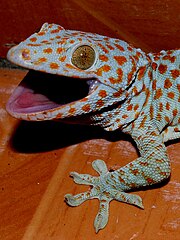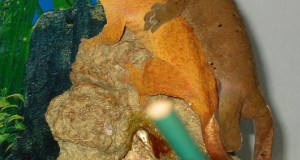Gecko fans are fortunate indeed (I included, as I’ve worked with a great many in zoos and the field)…over 150 species are available in the pet trade, many of which do quite well in modest enclosures. Among geckos we find lizards of every conceivable description – rainforest dwellers, desert specialists, burrowers, gliders, giants and many others. Today I’ll review some guidelines that will help you to set up terrariums for a variety of species. The following information can be applied to most available geckos, but details will vary. Please post below for information on individual species.
Natural History
The family Gekkonidae contains over 1,050 species. Among lizards, their diversity is exceeded only by the skinks.
Geckos may be found in deserts, rainforests, woodlands and grasslands. Some associate with people voluntarily –the aptly-named House Geckos favor our dwellings, while Tokay Geckos are established in Miami and other large cities. Five species are native to the USA, but approximately 15 have been introduced from elsewhere. Geckos range in size from the 1.2 inch-long Reef Geckos to the stout, 15 inch-long New Caledonian Giant Gecko.
The amazing ability of some geckos to run upside-down on ceilings was first recorded by Aristotle in the 4th Century. Gecko feet are being studied with a view towards creating new adhesives.
Setting up the Terrarium
Leopard Geckos and related species do well in simple terrariums, but spacious enclosures that mimic their natural habitat are best for most. In general, planted terrariums with plentiful hiding spots will encourage geckos to exhibit natural behaviors. Depending upon the species, your gecko’s terrarium should be furnished with live or artificial plants, rocks, vines, branches, hollow logs, caves and other such furnishings.
Aquariums work well for most geckos. Floor space is important for ground dwellers such as Fat-Tailed and Namibian Sand Geckos, while height is the primary concern for Gliding, Leaf-Tailed and other arboreal species.
Larger plastic terrariums can support a pair of House or Reef Geckos. Repti-Breeze Aluminum/Screen Cages are ideal for desert-dwellers that require well-ventilated habitats, and can also be used to provide sun exposure (glass and plastic filter out beneficial UVB radiation).
Exo Terra Glass Terrariums represent an important step forward in reptile-keeping. Available in a variety of styles and sizes, they feature hinged front doors, ventilation panels, artificial rock backgrounds and raised floors to house heating elements. Tall models are especially good for keeping arboreal species such as Tokay, Day and Gliding Geckos.
Substrate
In my experience, and that of zoo co-workers with whom I’ve discussed the subject, geckos rarely suffer impactions due to swallowed sand or soil. However, calcium deficient individuals may consume substrate in an effort to correct the problem. Calcium deficiencies are commonly seen in pet geckos of several species; please post below for further information. If you are at all unsure, feed your geckos from a tongs, or bowl (to limit accidental substrate consumption), or keep the animal on a terrarium liner until the problem is resolved. Sharp gravel should be avoided.
A mix of cypress mulch and sphagnum moss, or commercial rainforest substrate, is ideal for Day Geckos and others native to rainforests and humid habitats.
Sand, driftwood and large rocks can be used for the desert-dwelling Leopard and Web-Footed Geckos.
Frog-Eyed, Velvet and other grassland geckos do best with a sand/soil mixture.
Light
Day Geckos and other diurnal (day-active) species will not thrive without a source of Ultra Violet B (UBV) light. Natural sunlight is best, but be aware that glass and plastic filter out UVB rays, and that fatal overheating can occur very quickly. Repti-Breeze Aluminum/Screen Cages, which allow UVB to enter, can be used as permanent homes or to provide occasional sun exposure.
If a florescent bulb is used to supply UVB, (the Zoo Med 10.0 UVB Bulb is ideal for many species), be sure that your pet can bask within 6-12 inches of it. Mercury vapor bulbs broadcast UVB over greater distances, and provide beneficial UVA radiation as well. UVA/Halogen bulbs, while likely not essential, may encourage breeding and natural patterns of behavior.
Nocturnal species (i.e. Leopard, Tokay, Leaf-Tailed and Helmeted Geckos) do not need UVB radiation. Red/black night bulbs will enable you to warm and observe them after dark.
Heat
Ideal air temperatures vary widely among the different species. Ambient temperatures of 75-82 F, with a basking spot of 88-92 F, will suit most.
Incandescent bulbs should be used to maintain temperatures. A ceramic heater or reptile night bulb can be employed after dark. Leopard Geckos and other nocturnal species may also benefit from an under-tank heater in one section of the terrarium.
Large enclosures allow for the establishment of a thermal gradient (areas of different temperatures). Thermal gradients, critical to good health, allow lizards to regulate their body temperature by moving between hot and cooler areas.
Humidity
Humidity requirements also vary by species. Desert-adapted geckos must be kept dry, but should have access to a shelter stocked with damp sphagnum moss. Day Geckos and other rainforest dwellers do best in humid surroundings. In overly-dry climates, a small reptile mister or humidifier will be very useful. Most terrariums should be misted twice daily.
A Note on Diet
Most geckos feed largely upon insects, but many take nectar and over-ripe fruits as well; the voracious Tokay Gecko will consume small birds, rodents, frogs, snakes and lizards. A highly-varied diet is essential – Crickets and mealworms alone, even if powdered with supplements, are not an adequate diet for any species.
Please see the linked articles and post below for specific information on diets for various geckos.
Further Reading
Feeding Geckos: Beyond the “Cricket-and-Mealworm Diet”
Keeping and Breeding Malayan and Kuhl’s Flying Geckos
 That Reptile Blog – Reptile, Amphibian and Exotic Pet Care and Information
That Reptile Blog – Reptile, Amphibian and Exotic Pet Care and Information






Great article! Love leaf-tailed geckos, but have heard they’re very difficult to care for. Probably not a species I’ll go for, but maybe someday with enough time and money.
Thanks for the kind words, Paul. Leaftails are best taken when you have time/money…here’s an article (Pt I linked also) you may enjoy, let me know if you need more, best, Frank